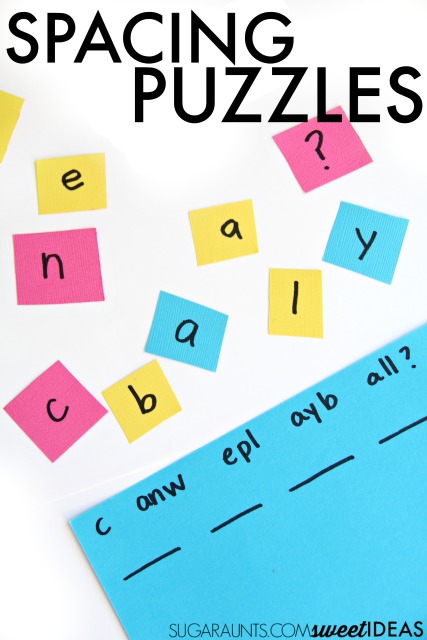
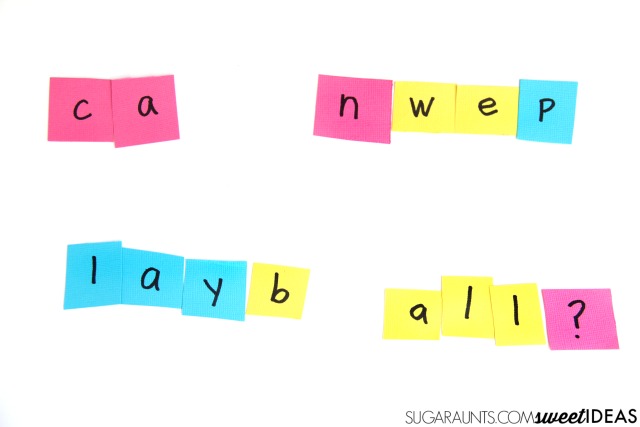
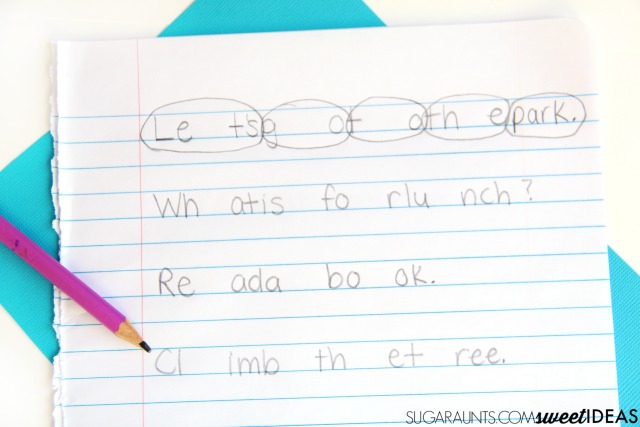
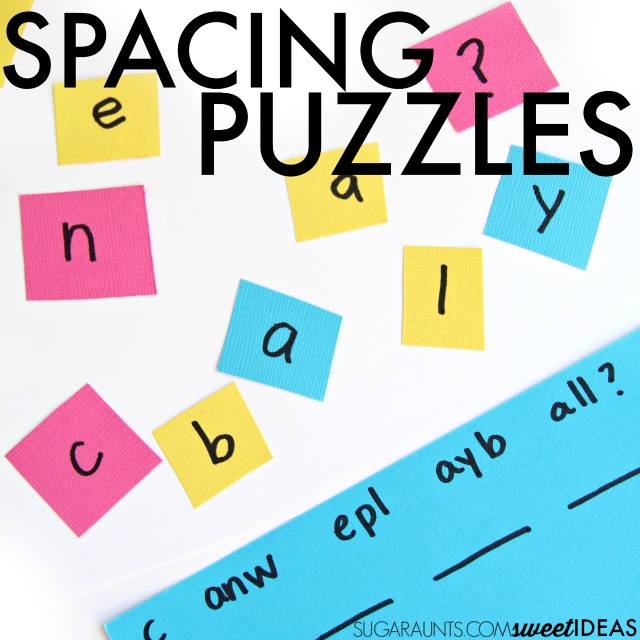
Looking for more activities to help kids work on spacing between words and letters? Try these:
Handwriting Spacing Tools
Space Martial Spacing Tool
Spatial Awareness in Handwriting




Looking for more activities to help kids work on spacing between words and letters? Try these:
Handwriting Spacing Tools
Space Martial Spacing Tool
Spatial Awareness in Handwriting
This handwriting technique is a strategy that I’ve used many, many times in school-based Occupational Therapy. It’s a handwriting strategy that uses boundaries of boxes and starting dots to help kids become more aware of letter size, letter formation, spatial organization, and use of lines.
The box and dot handwriting strategy is perfect for kiddos who are working on placing letters appropriately on the lines with awareness of tall letters (b, d, f, h, k, l, t) that should touch the top line, small letters that should reach half-way between the top and base stimuli lines (a, c, e, i, m, n, o, r, s, u, v, w, x, z), and tail letters that should drop down below the base line (g, j, p, q, y).
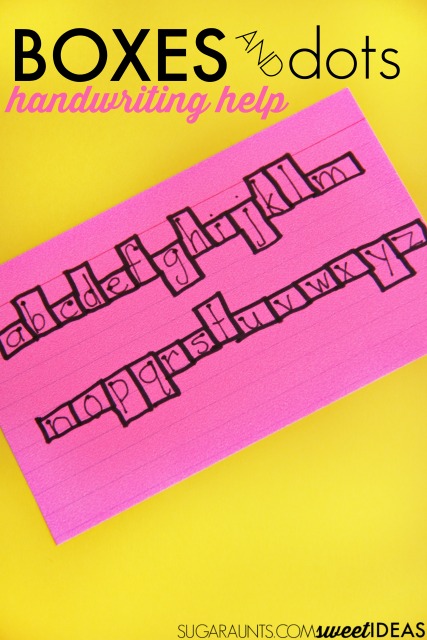
The dots in the boxes allow kids to practice letter formation by starting at the start point using the visual cue of a starting dot. This is perfect for kids who are working on improving letter formation in a single stroke (r, m, n, etc) or letters that require the writer to pick up their pencil for portions of the letter formation (a, d, etc). Sometimes, kids form the letters in “parts” as they build the letter instead of forming it accurately for speed and legibility. The starting dot can help with pencil placement to address this part of letter formation.
The sized boxes of this handwriting strategy are great for allowing kids to form letters with appropriate spacing, giving kids a definite visual cue for spatial awareness between letters and words.
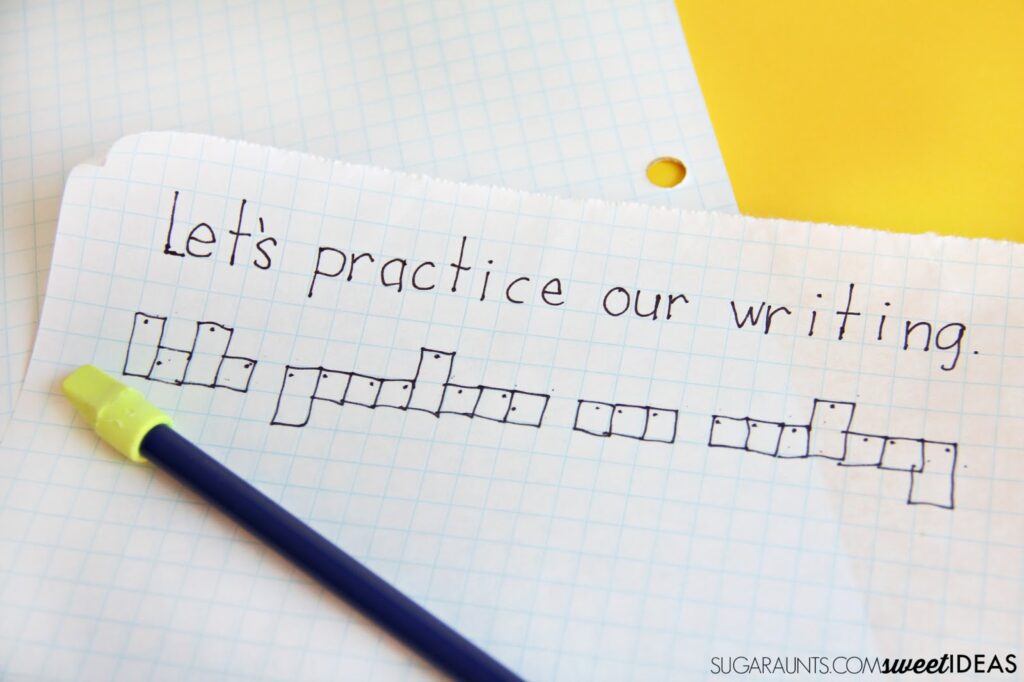
This handwriting technique can be used as an accommodation that allows students to learn letter size, placement, and formation. This accommodation can be used on regular paper, graph paper, or worksheets. When students start to demonstrate better understanding on letter characteristics, the boxes and/or dots can be faded out and eventually removed.
One strategy for grading down this tool is to first remove the dots from the boxes. Other students may benefit from removing the boxes before the dots. Simply adding a dot to writing spaces can provide the visual prompt needed for letter formation and placement.
Another technique for lessening the amount of visual cue is to transition students to a highlighter space for the bottom space or bottom half of lined paper.
Other times, using the boxes and dots on the words that are being copied are all that are needed for carryover of line awareness, letter formation, and spatial awareness.
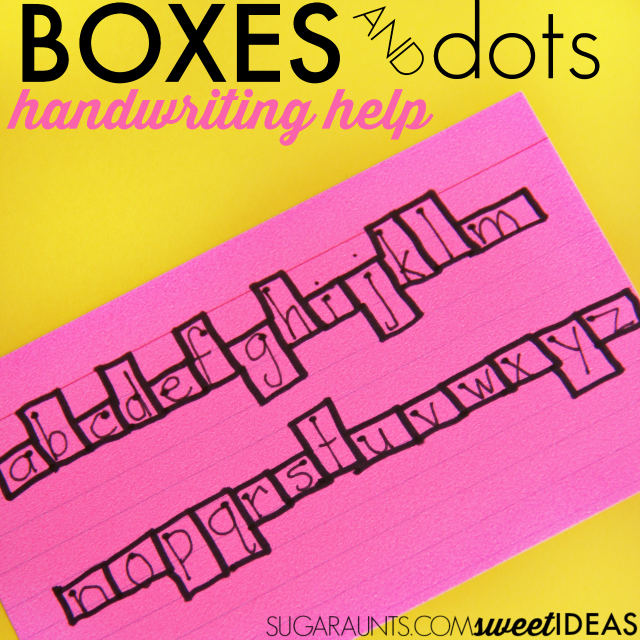
Love this handwriting trick? Stop over to see all of the simple handwriting tricks for better handwriting in our 30 handwriting series. This post is part of our Easy Quick Fixes to Better Handwriting series. Be sure to check out all of the easy handwriting tips in this month’s series and stop back often to see them all.
This map skills game for spatial concepts uses the ability to integrate spatial relations with what the eyes see with motor skills, or eye-hand coordination. It’s a fun map activity for occupational therapy or play!
Similarly, a drawing mind map incorporates spatial awareness on paper with complex thoughts and ideas, just like using a map as a skill-building game might in real life!
Summertime fun in our house means a lot of nights in the backyard with the family. We catch fireflies, play basketball in the driveway, play baseball on the lawn as the sun sets, have fires in the fire pit, and play heated games of tag, hide-and-go-seek, and make lots of summer memories. Most important of all, summer means time with family.
One thing that we love to do as a family is come up with fun games with a lot of running and active play. This backyard map game for building spatial concepts was a great way to play together as a family at the end of a hot summer day.
When the sun starts to set and the fireflies start twinkling, it is so much fun to create family adventures right in the backyard. We used our Energizer headlight and lantern in a family map game that added a directionality learning opportunity to play.
Drawing and creating maps is a great skill for kids to practice. Similarly, the process of using drawing mind maps builds on these visual motor skills, as well.
When kids picture a scene in their mind’s eye and use that image to draw a map on paper, they are using higher thinking skills and directional concepts like over, under, around, and through.
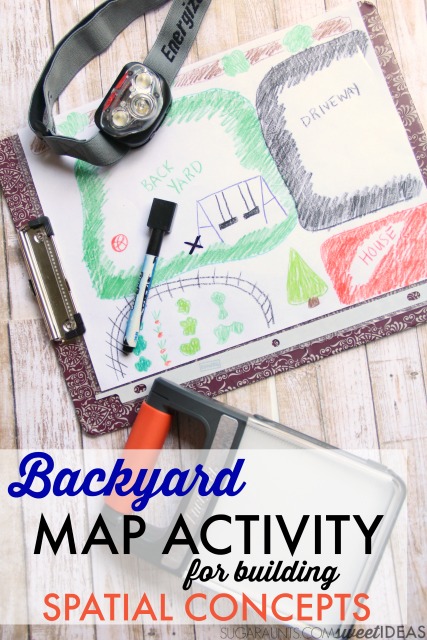
To play an outdoor map game that builds spatial concepts with the family, first ask your kids to picture their backyard.
Imagining a space and where items are in relation to others allow the child to use spatial relations as they draw them onto paper.
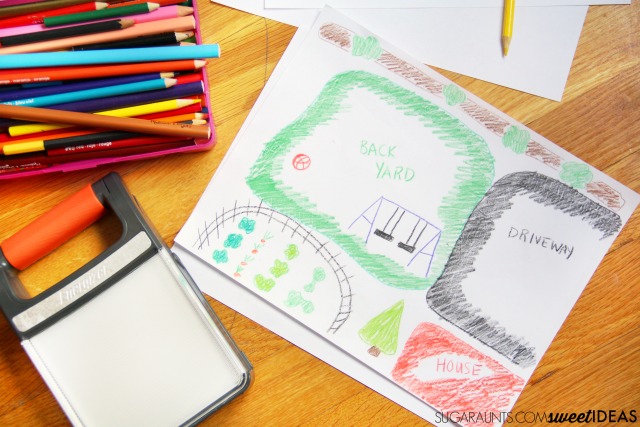
While drawing, kids can decide how to draw aspects of the backyard. They might sketch out a tree or a sandbox area or they might use geometric shapes to represent the items.
A circle could become a tree and a square could become a play area. Kids will have to picture the layout of the backyard and draw the features in relation to one another.
Spatial reasoning is an essential skill needed for tasks such as maneuvering down a crowded hallway, placing words on a line when writing, and understanding spatial concepts such as “left”, “right”, and “next to”.
Once the map is drawn, slip it into a plastic page protector and attach it to a clipboard. Grab your headlight, flashlight, or lantern and take the whole family outside to play a map game in the backyard.
1. To play the game, have one person hide a small toy like a rubber ball somewhere in the backyard.
2. Then, that person can use a dry erase marker to mark an “X” on the sheet protector to show where the item is hidden.
3. The kids can then use the map to locate the item by determining where the object is on the map. Doing this map game in the dark with a headlight or lantern is a great way to build map reading skills and spatial concepts because the child can’t just scan around the lawn to find the hidden object.
4. They must find the “X” on the map and read the map to locate the physical object hidden in the backyard.
5. Take the learning and spatial concepts a little further by asking your child to verbalize where the object is hidden and ask them to use directionality terms like “to the left”, “beside”, and “right”. They can describe the routes they would take to get to the hidden object.
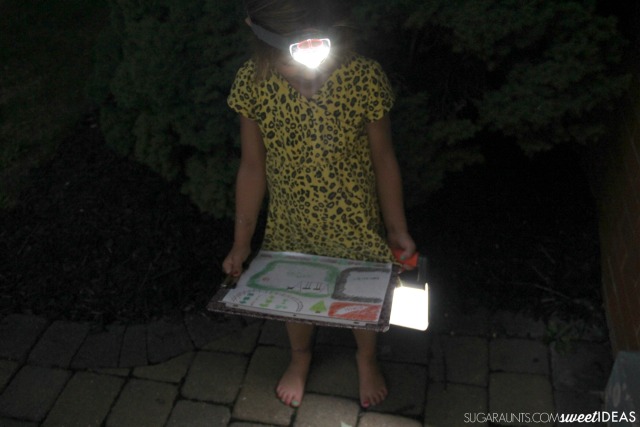
Using the clipboard to follow a map allows the child to focus on where they are going. My kids loved having a headlamp on for our backyard map game because it freed their hands to hold the clipboard, find and hide the hidden ball, and use the dry erase marker to draw an “X” for the other people in our family.
We played this game over and over again so the erasable dry erase marker and sheet protector allowed us to keep playing long after the sun went down!
I loved playing this backyard map game with my kids and we were excited to use our flashlights to play. The versatile lanterns can be used for so many memory-making activities with the whole family.
From filling up a homemade jar with fireflies in a lit area to lighting a S’more making tray, backyard flashlight games can help make the summer nights full of family memories. Add this outdoor activity to your list of backyard lawn games!
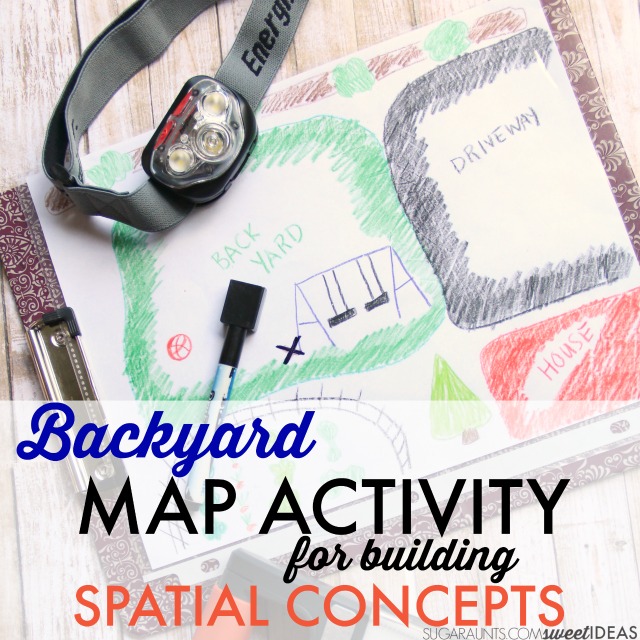

Colleen Beck, OTR/L has been an occupational therapist since 2000, working in school-based, hand therapy, outpatient peds, EI, and SNF. Colleen created The OT Toolbox to inspire therapists, teachers, and parents with easy and fun tools to help children thrive. Read her story about going from an OT making $3/hour (after paying for kids’ childcare) to a full-time OT resource creator for millions of readers. Want to collaborate? Send an email to contact@theottoolbox.com.
Working on the underlying pre-writing skills of handwriting is SO important in handwriting. This pre-writing lines activity is a fun Easter occupational therapy activity, but it’s also a powerful tool for building the foundation for handwriting. This is one of our favorite Wikki Stix activities to support pre-writing development.
You know we like to share handwriting activities around here, right? This Easter egg pre-writing activity is a fun way for young children to work on pre-writing skills in order to build a base for letter formation and pencil control. While we made this activity an Easter egg-ish shape, you could do this activity any time of year and use any shape to work on pencil control within a confined space.
Related: Try this pre-writing lines fine motor activity to incorporate heavy work feedback in developing prewriting lines.
Preschoolers and Toddlers will love this early handwriting activity! All of these skills are needed before a child can form letters and work on line awareness in Kindergarten. If a child is showing difficulty with forming diagonals in letters like “A” or “M”, this would be a fun way to work on building the skill for improved legibility in written work.
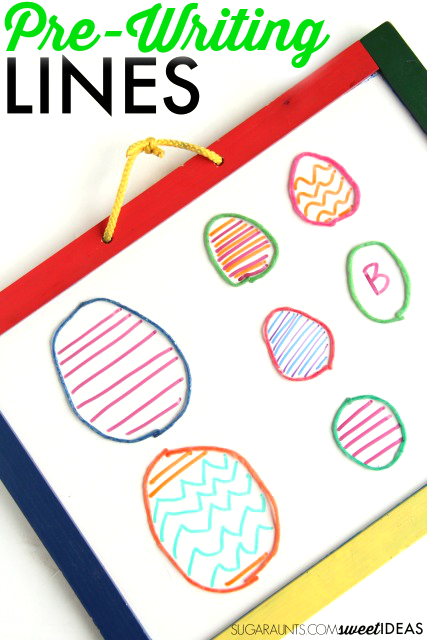

Dry Erase Board
Dry Erase Markers
Wikki Stix (Amazon affiliate link)
Using THIS Dry Erase Board worked out great for this activity, because we did the same writing activity on the reverse side, which has a chalkboard. Writing with small pieces of chalk is a fantastic fine motor and intrinsic muscle strengthening activity to work on the fine motor skills needed for endurance in drawing and coloring, as well as the tripod grasp needed for an appropriate grasp on the pencil. A chalkboard surface for drawing lines is much more resistant than a smooth dry erase surface, providing more feedback during line formation.
We used these Dry Erase Markers for their fine point and colorful selection, which made making these Easter eggs a creative activity, too. My preschooler loved picking out the colors to create patterns.
The last item we needed for this handwriting precursor activity was (Amazon affiliate link) Wikki Stix. As an Occupational Therapist, I feel like I’m always pushing the benefits of Wikki Stix. The bendable and mold-able sticks are a great fine motor and handwriting tool. In this activity, I bent one or two wikki stix into an egg shape. You could also make circles, squares, or any shape for your handwriting task.
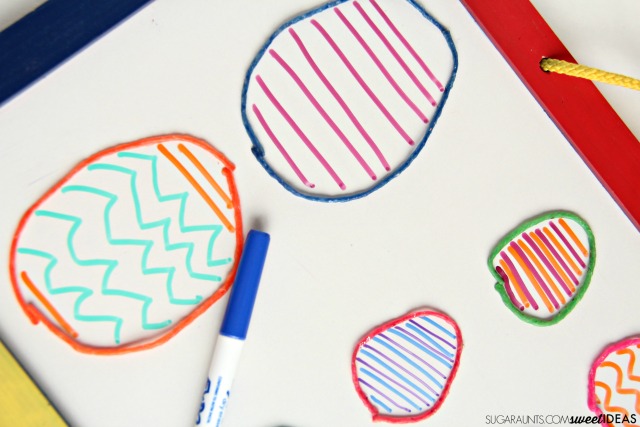

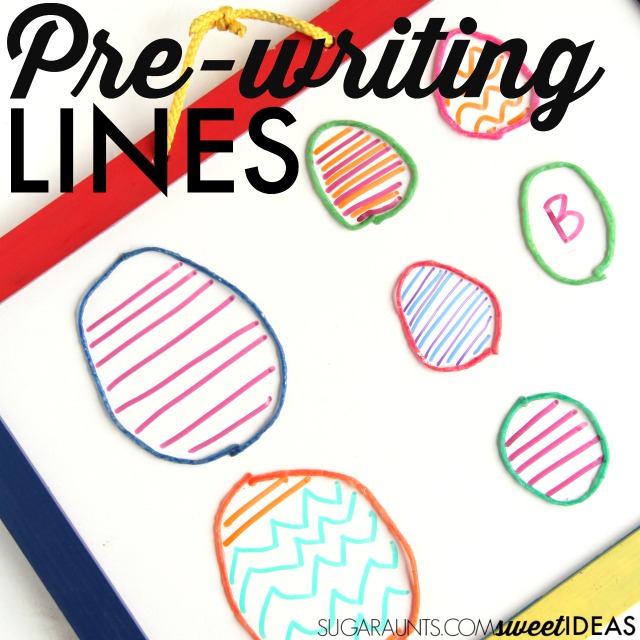

Some of my favorite Handwriting activities are multi-sensory and incorporate motor planning activities for building pre-writing lines as a foundation for handwriting:
Score Fine Motor Tools and resources and help kids build the skills they need to thrive!
Developing hand strength, dexterity, dexterity, precision skills, and eye-hand coordination skills that kids need for holding and writing with a pencil, coloring, and manipulating small objects in every day task doesn’t need to be difficult. The Spring Fine Motor Kit includes 100 pages of fine motor activities, worksheets, crafts, and more:
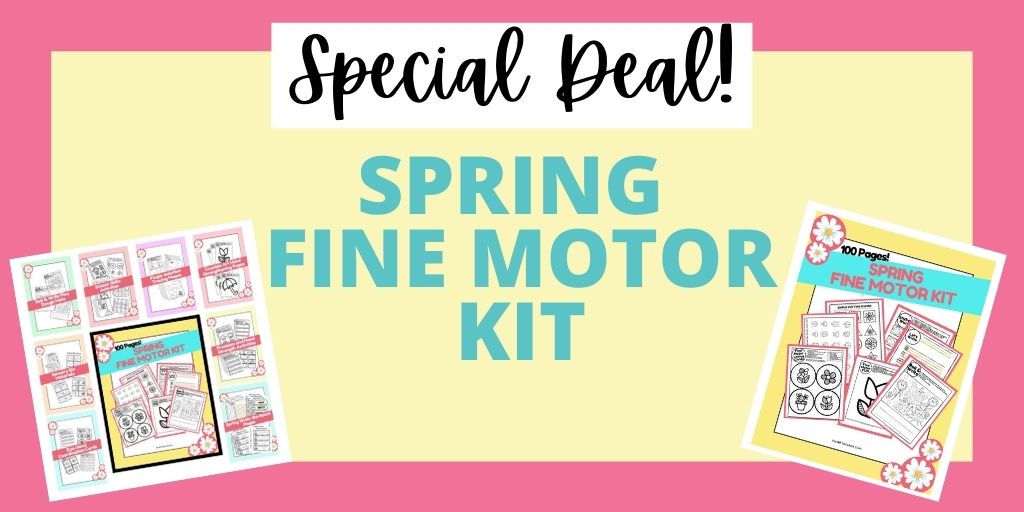

Click here to add this resource set to your therapy toolbox.
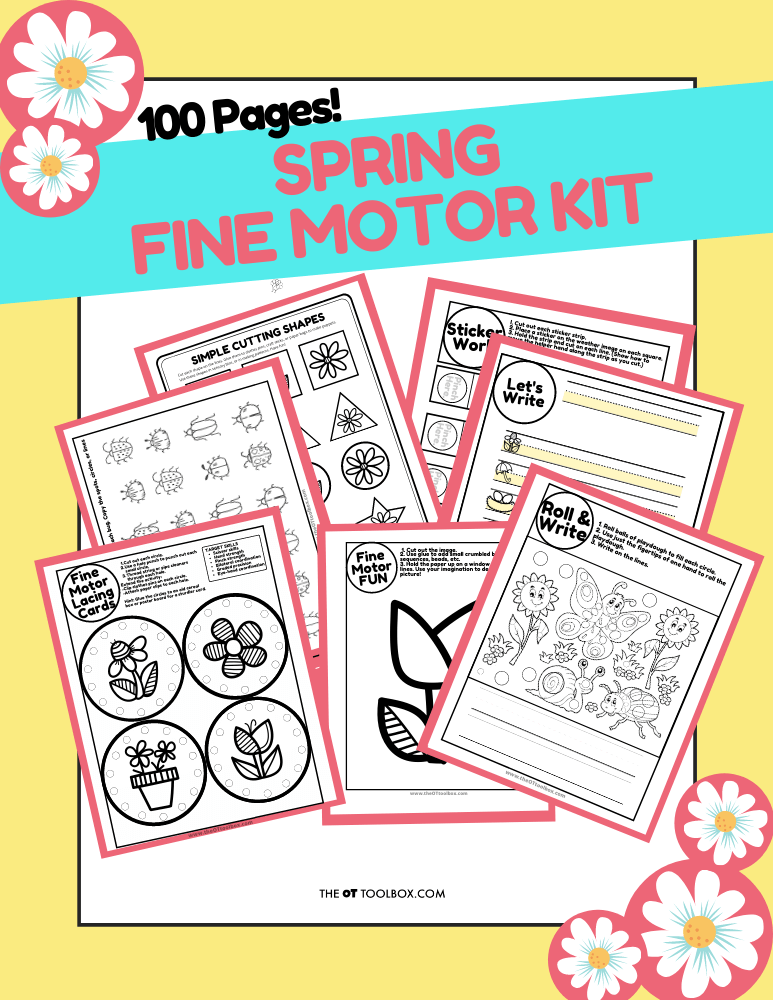

Grab your copy of the Spring Fine Motor Kit and build coordination, strength, and endurance in fun and creative activities. Click here to add this resource set to your therapy toolbox.




Colleen Beck, OTR/L has been an occupational therapist since 2000, working in school-based, hand therapy, outpatient peds, EI, and SNF. Colleen created The OT Toolbox to inspire therapists, teachers, and parents with easy and fun tools to help children thrive. Read her story about going from an OT making $3/hour (after paying for kids’ childcare) to a full-time OT resource creator for millions of readers. Want to collaborate? Send an email to contact@theottoolbox.com.
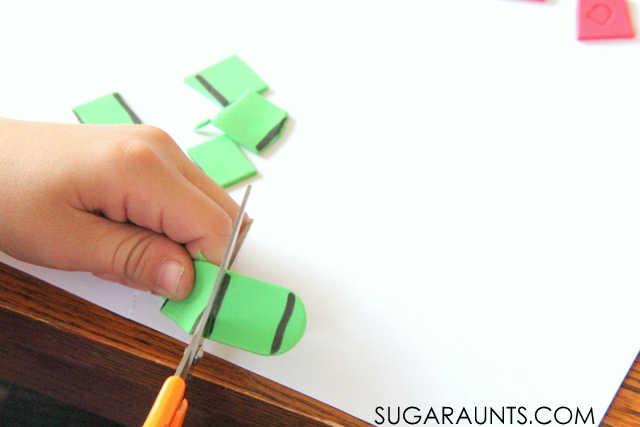

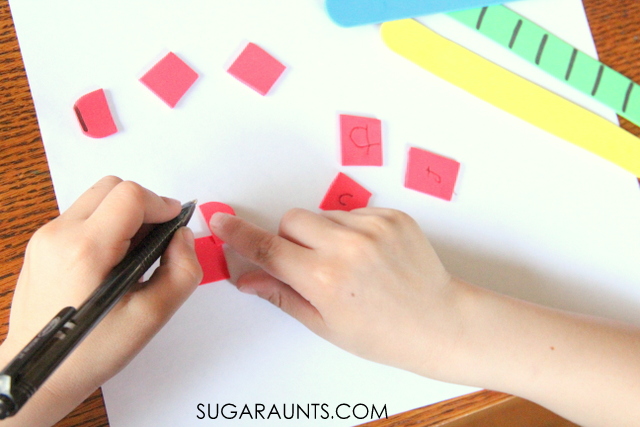

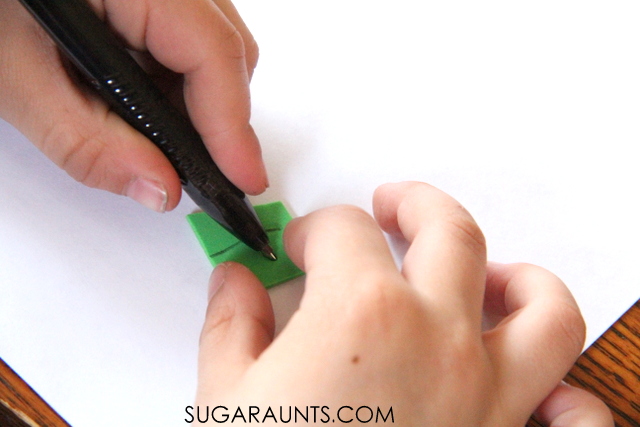

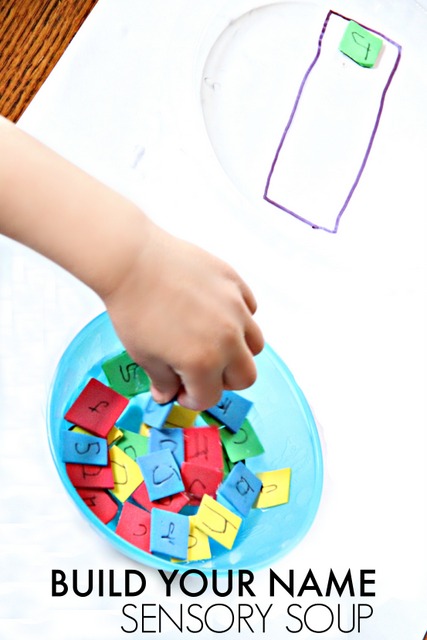

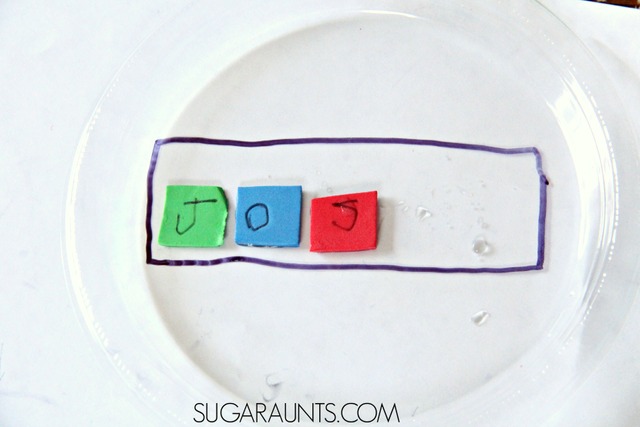

High-Contrast Letter Formation
Sensory Letter Formation Practice
Tracing Letters: Letter Formation Handwriting Practice with Chalk
Tracing Lines with a DIY Light Box
Improving Pencil Grasp With Fine Motor Play Activities
Fine Motor Coordination with a Cereal Box (activity to improve tripod grasp)Gift Guide: Toys to Improve Pencil Grasp
This post is part of Preschool Powol Packet’s name recognition writing series. Stop by and see all of the great ways to practice name formation.
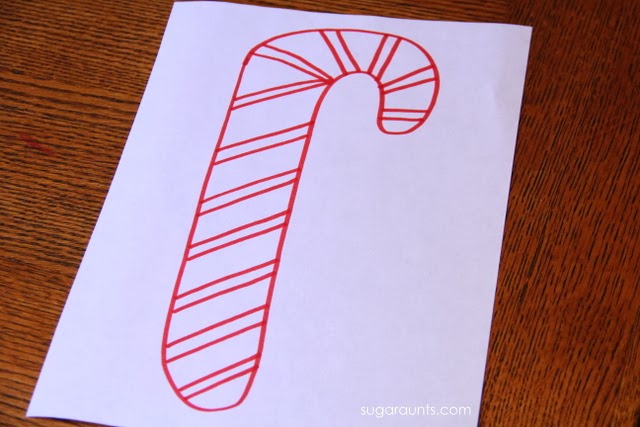



He kept his lines within the stripes very nicely, and did not often go over the edges of the candy cane. This is a great activity for a new writer!
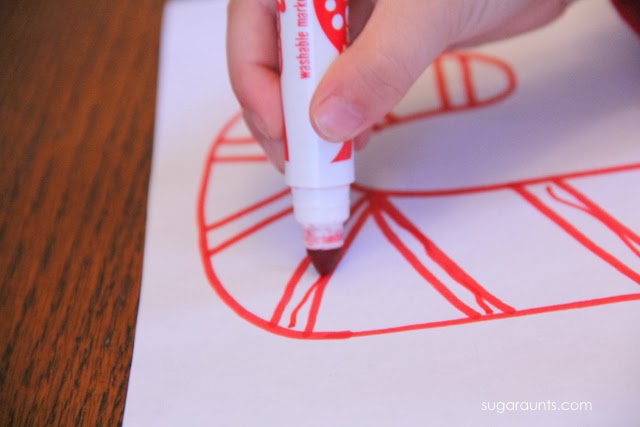

Our next activity was encouraging tripod grasp to manipulate pony beads. I had Little Guy pick up the beads and place them onto the bulbs of a Christmas Tree. You may have seen this picture on our Instagram feed or Facebook page.
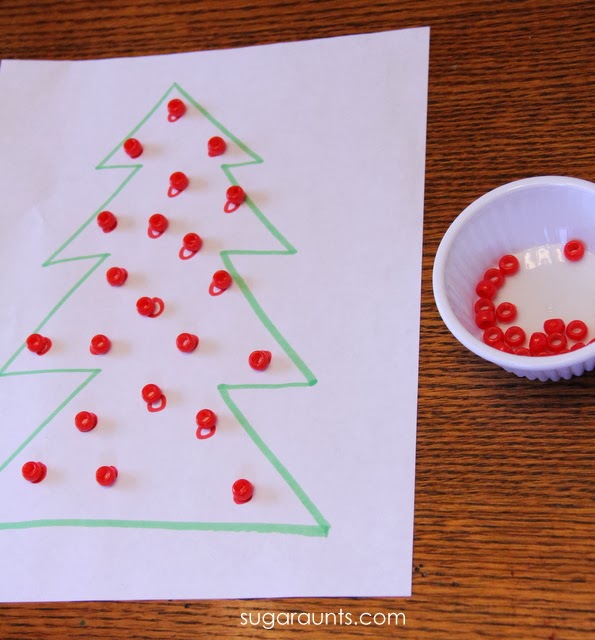

Little Guy had to keep the beads on the circles and really concentrate on the lines. To manage the beads and place them gently on the circles, encouraged a tripod grasp with extended wrist for improved pencil control.
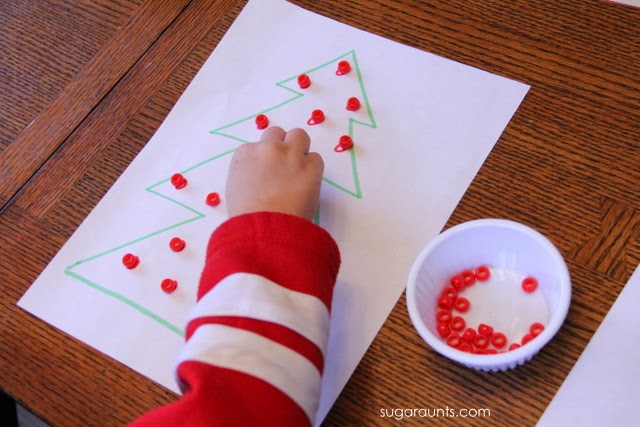

This Christmas tree was another easy DIY pencil control worksheet to throw together. Baby Girl (age 2) really liked this activity too.
I didn’t capture a picture of the next step, but I had Little Guy connect the bulbs with a pencil. I asked him to keep the pencil from going in the bulb, because it might break the light! Connecting the dots and concentrating on the lines of the circles was a great way to work on pencil control.
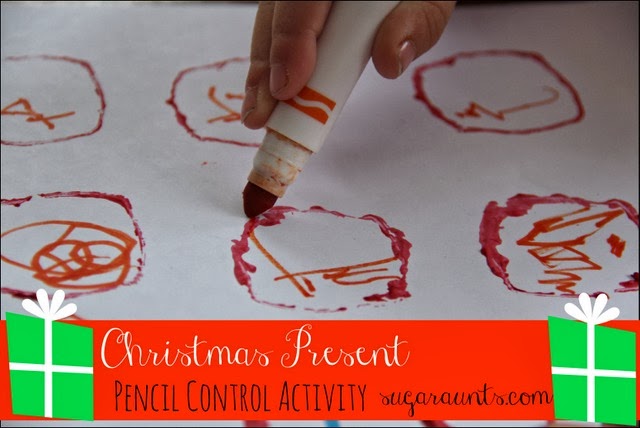

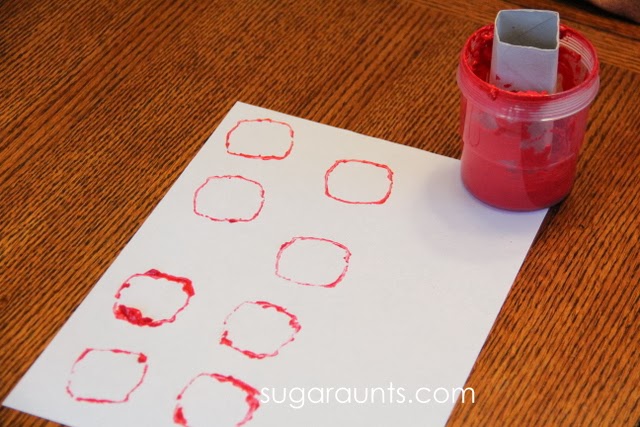

We waited until the next day when our present squares were dry.
I showed Little Guy how to make crosses on the presents (over Baby Girl’s added decorations!) so he could practice simple copying. He was to make the lines top to bottom and left to right to encourage improved pencil control in letter formation. He did pretty well!
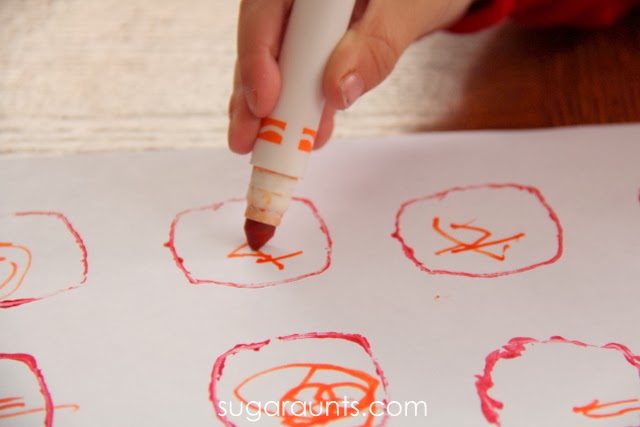

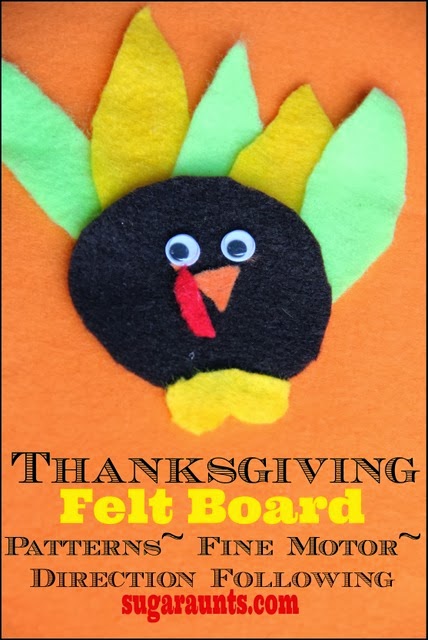

Little Nephew is a smarty when it comes to identifying colors. He told us all of the colors of the feathers easily!
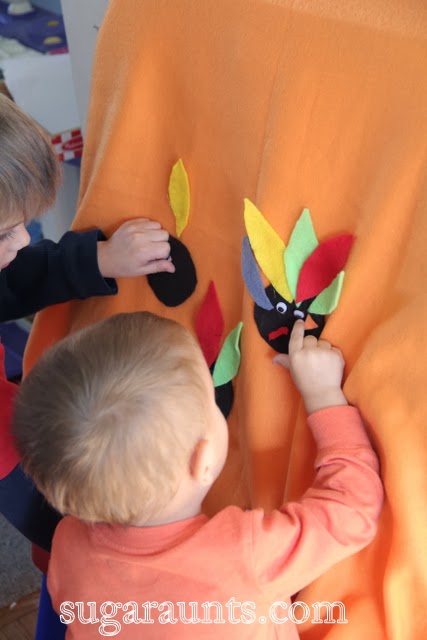

Let’s cover a few different directional concepts; This over, under, around, and through activity for preschool is a spatial relations concept. These positional concepts are an important part of preschool development.
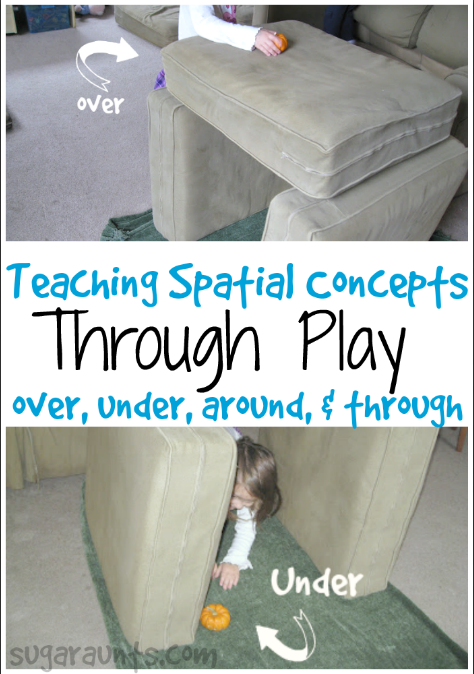

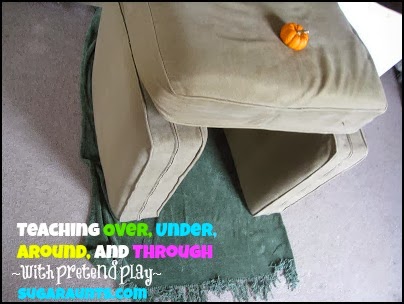

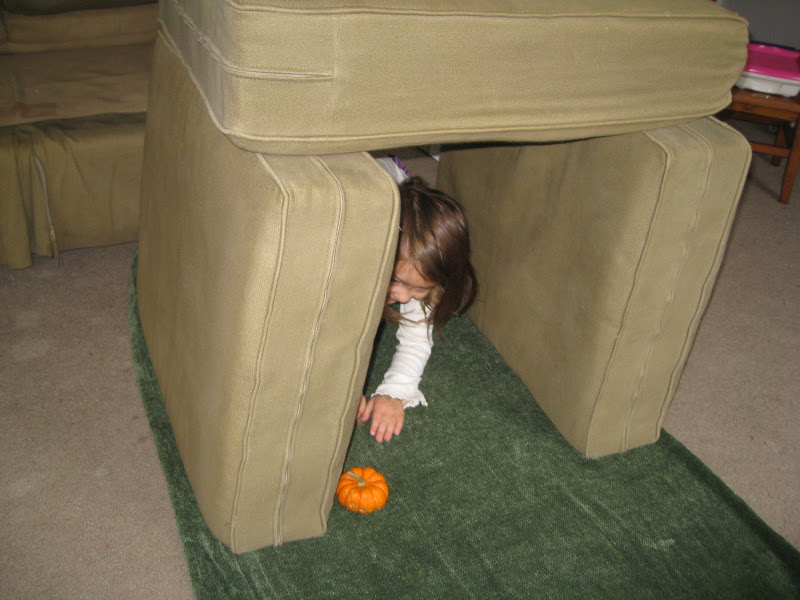

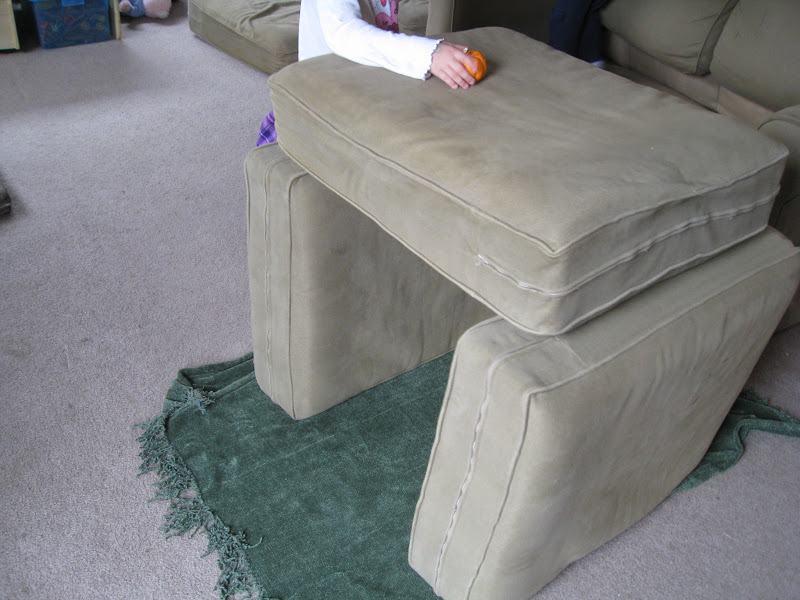

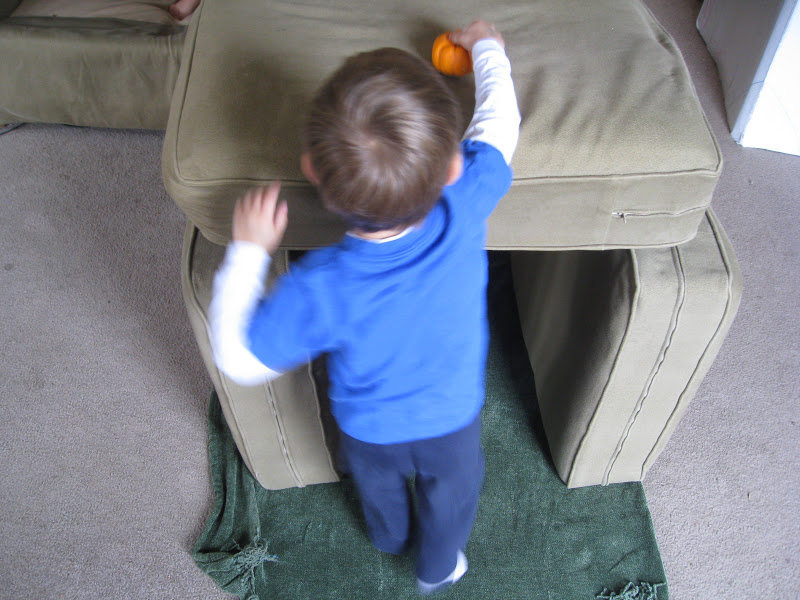

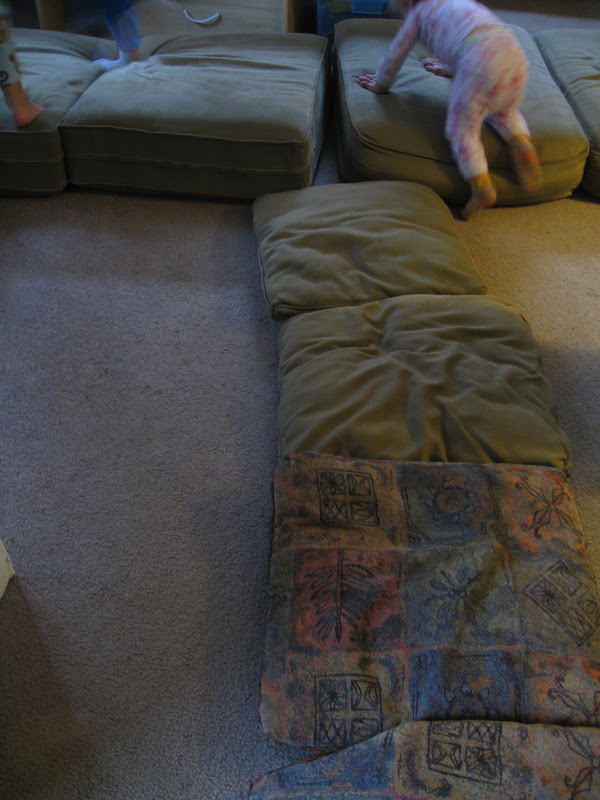

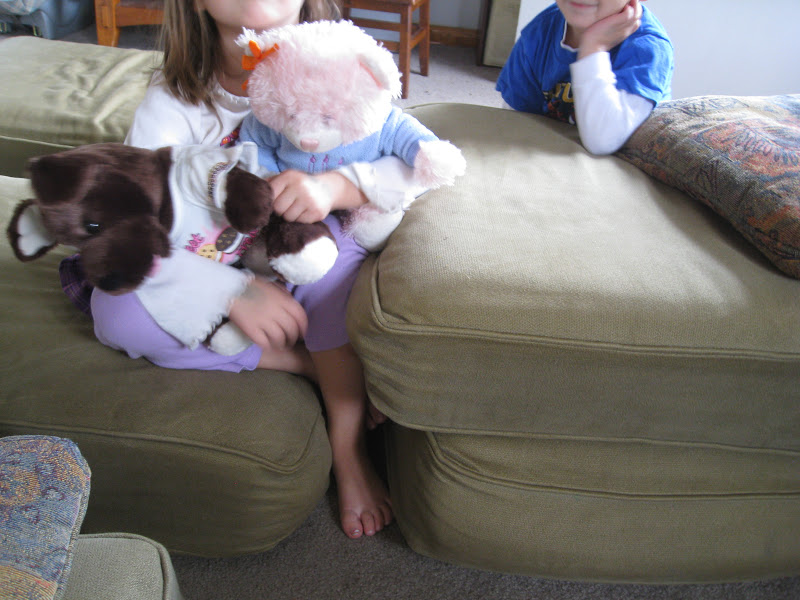

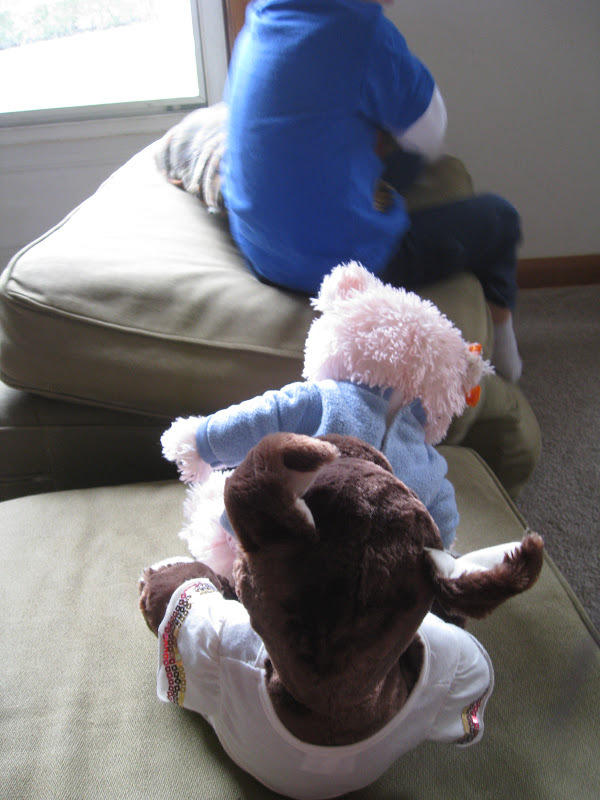

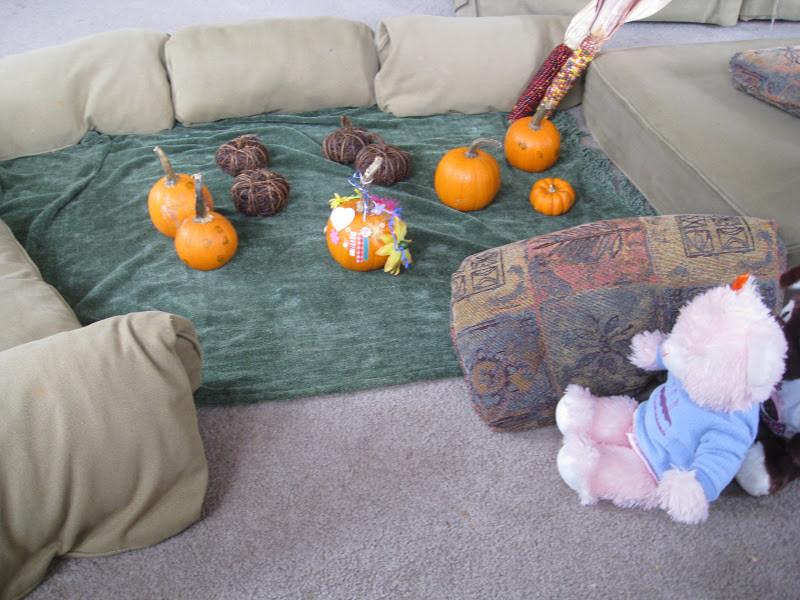

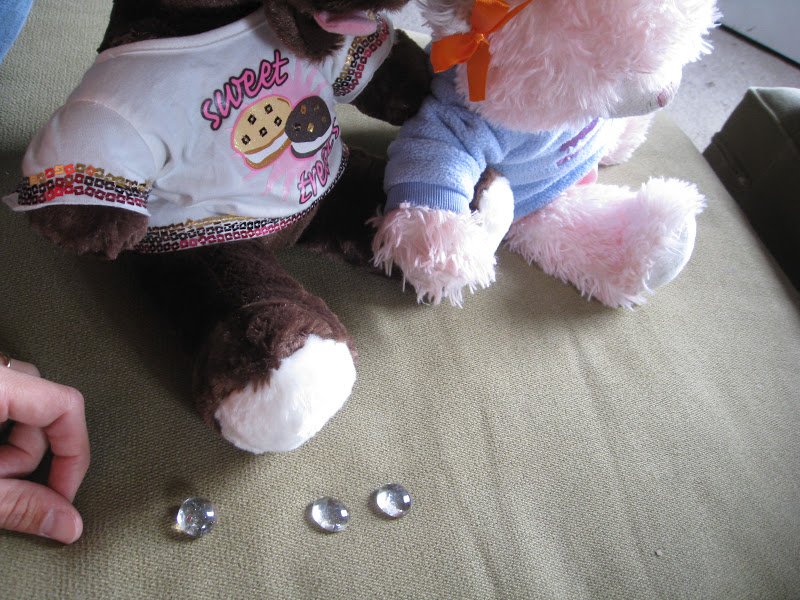





Colleen Beck, OTR/L has been an occupational therapist since 2000, working in school-based, hand therapy, outpatient peds, EI, and SNF. Colleen created The OT Toolbox to inspire therapists, teachers, and parents with easy and fun tools to help children thrive. Read her story about going from an OT making $3/hour (after paying for kids’ childcare) to a full-time OT resource creator for millions of readers. Want to collaborate? Send an email to contact@theottoolbox.com.